- Qualcomm Launches Snapdragon 4 Gen 2 Mobile Platform
- AMD Launches Ryzen PRO 7000 Series Mobile & Desktop Platform
- Intel Launches Sleek Single-Slot Arc Pro A60 Workstation Graphics Card
- NVIDIA Announces Latest Ada Lovelace Additions: GeForce RTX 4060 Ti & RTX 4060
- Maxon Redshift With AMD Radeon GPU Rendering Support Now Available
Intel Xeon X3210 2.13GHz Quad-Core B3-Revision
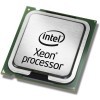
One of the most popular CPUs on the market right now is the Q6600, thanks to the fact that it offers four cores at 2.4GHz. But what about the Xeon’s? Their prices are also more affordable now, with their X3210 2.13GHz retailing for $260. Read on as we pit this Quad-Core against the rest of our fleet.
Page 9 – Overclocking, Final Thoughts
If you’ve owned a Quad-Core processor in the past, chances are, you are well aware that overclocking is not always so peachy. On Dual-Cores, there is a lot of overclocking headroom, but cram four cores together under the same IHS and it’s hit or miss. Another issue to take into consideration is heat… that’s been my biggest issue with overclocking all three Quad-Cores on hand.
As mentioned in our recent review of Intel’s QX6850, there is no reliable way to record temperatures from Quad-Cores, however from our tests, Everest 4.0 seemed to be pretty reasonable. During overclocking, the biggest instability hits would occur whenever Everest reported a core at 100°C or higher.
If you have a Quad-Core and have intentions to overclock, it’s important that you have a very nice air cooler or water-cooling setup and do your best to keep the voltage no higher than 1.45v.
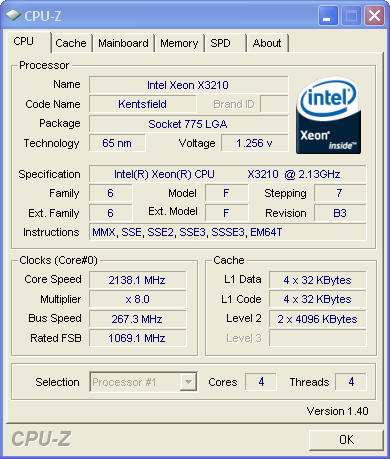
The first goal we set when finding a max overclock, is to first find a max overclock with stock voltages. We chose to stick with our usual 1.30v and managed to hit 2.48GHz. Nothing extreme, but a nice modest overclock regardless.
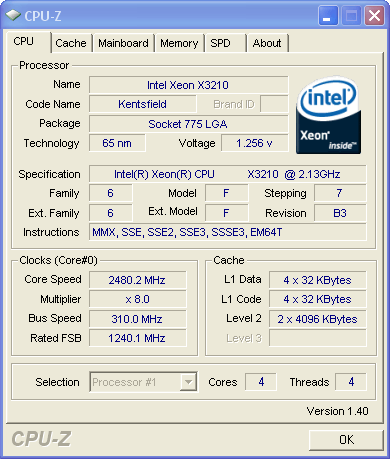
With a slight voltage boost (1.35v), 2.67GHz became completely stable, while never reaching the temperature threshold. In the end, this was our top overclock, while retaining stability. Allow me to quote a previous review:
For an overclock to be considered stable, 3D Mark 06 is looped three times, followed by at least eight straight hours of SP2004’s Small FFT test, one instance per core. The computer must also be turned on and off multiple times, to make sure that the motherboard is going to cooperate. As a final test, the computer is left turned off for at least a half-hour, then turned back on to make sure it performs normally.
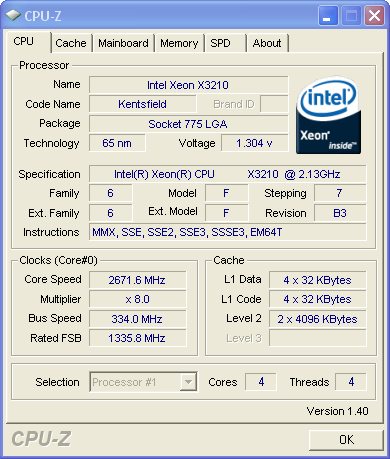
Overclocks that we call stable, have actually proven stable. Major overclocks are nice, but when they are unstable, we could care less. That said, I believe our processor has further pushing room, but we hit a temperature block. At 3.0GHz for example, the computer would reboot shortly after Everest 4.0 reported 100°C on the CPU (which also seems to be the highest that Everest will report).
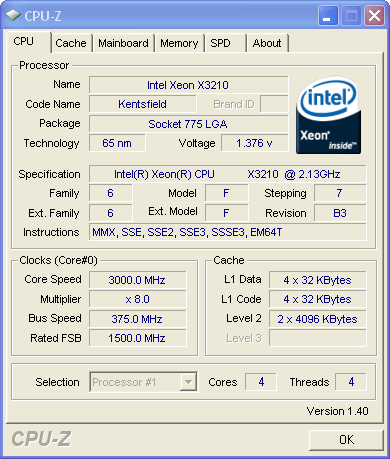
I believe if you have a solid water-cooling setup, and even possibly a huge air cooler in a low-temp room, then you should be able to accomplish a similar overclock easily. Our testing environment hovers around 80°F at any given time, with >80°F being a rarity. Coupled with the fact that our water-cooling block has been switched around at least 30 times, our testing might not be representative of most systems.
As a ‘single-core’ though, 3.0GHz was absolutely stable, however not when all four cores were stressed at once. It’s with that, that I believe it could be entirely stable with proper cooling. For overclockers looking for pure frequency without the care of stability, there’s no doubt this CPU can be pushed beyond the 3GHz mark.
With the recent Intel price drops, many options opened up for consumers who were looking to build a new PC. It’s a great situation to be in. No matter what CPU you pick up, you will be walking away with one that offers killer performance, for not much money.
How the X3210 compares to others out there is a tough one. Dollar for dollar, I would easily pick up the Q6600 for the fact it has a faster clock speed and a 9x multiplier, while the X3210 has only 6x – 8x multipliers. This normally won’t mean that much anyway, since most motherboards will hit 400FSB with ease, which would give you 3.2GHz. As we found out in our case though, that clock speed will not likely be possible for most people, without heat getting in the way.
If you are simply looking for a Quad-Core at the best price, you cannot go wrong with this one. It retails for $260 – $270 and offers four cores at a very respectable clock speed. It’s rare to see a value like this… and just last year, it would have not crossed our minds. That said, if you -are- interested in overclocking a Quad-Core, do what you can to find a G0 revision, as they have slightly lower TDPs and tend to overclock better.
With Penryn right around the corner, the decision to pick up a processor now is made more difficult. However, Penryn is not going to launch at rock bottom prices like the Core 2 Quads are now, because they are revamped architectures, not simply clock bumps. With prices this low, you are not going to go wrong, with whatever you choose.
If you have a comment you wish to make on this review, feel free to head on into our forums! There is no need to register in order to reply to such threads.
Support our efforts! With ad revenue at an all-time low for written websites, we're relying more than ever on reader support to help us continue putting so much effort into this type of content. You can support us by becoming a Patron, or by using our Amazon shopping affiliate links listed through our articles. Thanks for your support!





